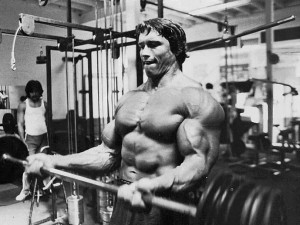As trainers we never stop learning, you can’t, there is simply too much to know. Even things you’ve done a certain way for years can suddenly take on new meaning, like a normal barbell bicep curl for instance.
This blog post isn’t about business, marketing, lead generations or pushing profits into the stratosphere. Yet if it get’s you thinking and improves your skill as a trainer (or mine, or someone else’s) then it is absolutely about business, clients success, retention and industry longevity. All are inclusive of exactly what the Profitable Personal Trainer is all about.
So let’s have some fun, let’s talk about bicep curls. (And for the record I can’t even mention the word bicep without thinking about Pumping Iron and good old Arnold and Franco training back in the day.)
Barbell bicep curls are for me a product of an era gone by, my bodybuilding days. When I think about bicep curls I can’t help but think about one of my major mentors and role models from my younger days, you might recognize him. When vanity was my primary objective and having those big hanging biceps was part of the job description I did a lot of bicep curls. Over the years as I evolved as a trainer their use faded, as truly for most it’s not a movement that serves for much of a variety of purpose. We know that many of our clients will often present with rounded shoulders, the sign of a deteriorating upper shoulder girth, shortened pecs, internal rotators and quite often shortened biceps.
In its simplest form the bicep curl doesn’t really seem like a logical choice dealing with someone with rounded shoulders and deteriorating posture. In no way am I disputing this but then sometimes the most difficult part of working with a client as actually physically getting them to perform, activate or use the actual muscles that you want them to. I’m sure like I have, you’ve found scapular retraction/manipulation to be one the most common, and often difficult, focal points of improvement for clients.
Recently I’ve taken a keen interest in Serratus Anterior and it’s role. I’ve always found it interesting that if we removed all the muscles from our shoulder blade it’s basically only attached to our skeleton at the end of the collarbone where it meets the sternum. Without the muscles holding it in place it could move all over the place, yet containing the shoulder joint it’s a major stabilization point for our arm and many of its movements as well as our head. It’s easy to see through our life, with most of our life spent moving in front of us, why the muscles of the shoulder girth could become unbalanced and dysfunctional. To me it’s even more frightening to think about how bad it really could get with the only structural anchor point for the shoulder girth to be at the sternum, this creates a broad range of displacement for a lot of muscles involved in a lot of movements.
Anyways, serratus, as you probably know the serratus originates on the back side of the shoulder blade, it wraps around our torso attaching to a number of ribs on the front side of our body. In conjunction with other muscles of the shoulder girth one of the big things it can do is flatten the shoulder blades (scapula) against the rib cage. Because of the convenience generally of our lives this is typical point of dysfunction. Our lives are typically not physically demanding enough to encourage efficient, regular neurological recruitment of the serratus to flatten the shoulder blades.
If you Google or search YouTube for improving serratus function you’ll undoubtedly find modified versions of push ups and presses, all of which I am a fan of and use extensively. However from a pure coaching standpoint recently I have had tremendous success with my clients using a light barbell bicep curl.
When my client is performing the barbell bicep curl I will stand behind them cuing them to flatten the shoulder blades and squeeze the bottom of the scapula together. I ask them to try to maintain this position while performing the bicep curl. I then place my hands on top of the shoulder with my thumbs sitting just below the ridge separating supraspinatus and infraspinatus so I can detect any movement.
Just about everyone moves a little, and this greatly decreases the efficiency of movement of the bicep curl. But what it does do is give them an immediate sense of what their scapula is doing, feeling the activation of lower trapezius and serratus as the attempt to keep the scapula from moving or stabilizing by elevating the traps with their upper fibers. This ineffective bicep curl has proven to be extremely beneficial in establishing the mind to muscle connection for better serratus activation and postural improvement.
The best part is your clients can see and feel an immediate difference. We all know with great results comes great client retention, increased customer referrals, and the development of your brand. Just maybe bicep curls can find a place into your business building strategy afterall.

 YES! Contact me today to schedule a FREE no obligation consultation and trial workout.
YES! Contact me today to schedule a FREE no obligation consultation and trial workout.